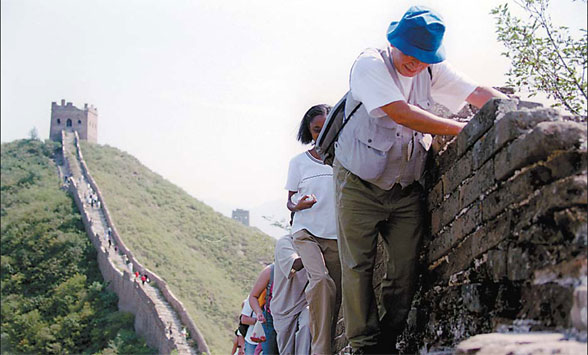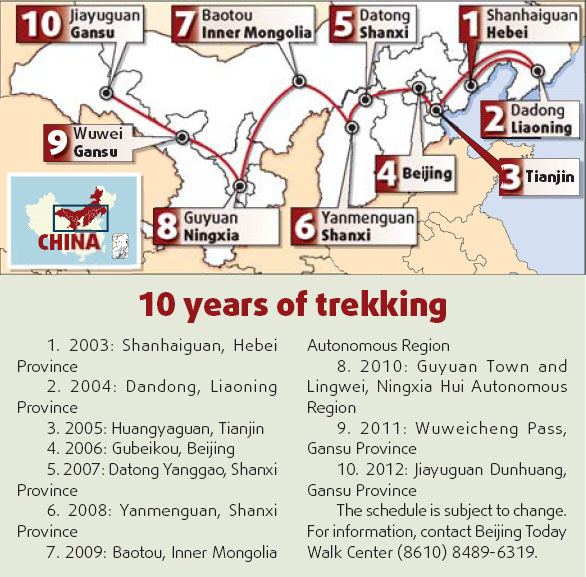|

Tourists from home and abroad trek along the Great Wall in Beijing.Xiao Huaiyuan
|
A tear rolls slowly down Liu Yurong's cheek, her large, dark eyes betraying a quiet sorrow. "It is my birthday today," the 25-year-old says. A biting wind stings her face as she stands above a deep gorge beside the ancient Great Wall at Ningwuguan, North China's Shanxi Province.
"My grandfather was from here. It was his wish that I come here to stand on the Great Wall in the motherland. Today, I fulfill his wish. But he is dead," Liu says.
Born and raised in North China's Inner Mongolia Autonomous Region, Liu says her parents phoned each day and repeated her grandfather's words, inspiring her to become a guide for this year's leg of a decade-long program that aims to conquer the far reaches of the Great Wall by foot.
Launched by the China Volkssport Association (CVA) with Beijing Today Walk Center, 10 Years Great Walk on China's Great Wall began in 2003 at the Shanhaiguan section, where the wall meets the sea in North China's Hebei Province. The final section in 2012 will be the western end at Jiayuguan Pass, Northwest China's Gansu Province.
This year's fifth leg began at Datong in Shanxi in September. Over four days, hikers followed the Great Wall's trail to where it borders Inner Mongolia, and meets the Yellow River.
Datong was the capital of the Northern Wei Dynasty (AD 386-534), when the Great Wall's northern borders were extended by 1,000 kilometers from Chicheng County, in North China's Hebei Province, to Wuyuan County in Inner Mongolia. Six important garrisons were built north of the Great Wall to protect Datong, then known as Pingcheng City. An inner wall was also constructed of earth. Lower than the original wall, it circled Datong, stretching some 500 kilometers to the east bank of the Yellow River.
Several of the 45 tourists comprising 2007's Great Walk group have returned from previous years, while some Japanese tourists - including representatives from sponsor company Toshiba - also joined the group. Most are Chinese, and there are many retirees among them.
Mao Xiaoyan, 62, aims to do every leg of the walk. "Because I love the Great Wall," says the retired engineer, who is always near the front of the pack.
Jason Zhang and his wife Pan Tong also hope to be there for the Great Walk finale in 2012, having joined the tour in previous years. Zhang, a former Tsinghua University professor, says this is their chance to explore more of their own country. The middle-aged couple has traveled extensively in Europe, living in Switzerland for three years. Their daughter is now studying in Germany.
Besides the opportunity to discover different cultures defining life at various parts of the Great Wall, the 10 Years Walk project provides a unique personal challenge, organizers say.
"Only with at least 10 years can we experience the greatness and fascination of the Great Wall," CVA's Jin Qiao says. "Also, 10 in Chinese often refers to forever. This means the experience of walking the whole Great Wall will become an infinite memory of one's own."
The group arrives by bus at Deshengbao Village and is greeted by locals with a reception of music and dance. The dusty village lies behind a wooden city gate - believed to be the last remaining in China - and has stood more or less unchanged for a century.
Beyond the village walls, a section of the Great Wall dating from the Ming Dynasty (1368-1644) stretches over fields against the backdrop of a piercing blue sky. The wall's original brick casing is all but gone, and erosion has reduced it to a dry, earth barrier, rising to a grassy peak at a former garrison that guarded a strategic pass.
|

The site of an ancient city gate at Yanmenshan, Shanxi Province.Viva Goldner
|
The following day's trekking begins at Wanjiazhai, where the earthen remains of the wall run along the banks of the Yellow River. Relics of an ancient village stand on a ridge above the river, including an outdoor opera theater, a small temple and a beautiful, old gnarled tree in a central courtyard. Below the wall are parched fields where corn, melons and fruit trees had been planted, but now appear untended but for a couple of forlorn scarecrows keeping watch.
The long, narrow road from here to the next destination circles sweeping mountains, dipping on one side to terraced, green fields interspersed with cave houses built into the cliffs. To the other side is the vast Yellow River, curving like emerald glass around rough yet green terrain jutting into the water.
It is a steep route on a remote road under reconstruction, and at one point, passengers must alight to allow the bus gumption to make it up a particularly sharp rise. Finally, the group is delivered to a magic valley that one ambitious developer hopes will soon be a tourism draw.
Perched on a hill high above water in Laoniuwan, dubbed one of the most beautiful valleys in China, this place is like a secret garden of children's storybooks.
The original Great Wall meets the Yellow River from the mountains opposite, and has been supplemented by a restored section with a future mind to pulling the tourist dollar. Small boats are moored by the riverbanks, for besides the precarious road route, access to the secluded valley is possible by water.
A Mongolian entrepreneur is rumored to have purchased land on the mist-shrouded peak, and constructed charming, wooden cottages equipped with modern facilities, pretty gardens and even a "bar street". Visitors are also expected to have the option of camping at the settlement, which is not yet open for business.
By the third day, the sense of camaraderie that typically develops among group members spending time in close quarters is strong. After hiking a rugged section of the wall and the site of an outer pass at Ningwuguan, Jin stops to feed grass to a donkey. He is quickly joined by five or so others, and in high spirits, they whip out cameras and set about taking yet more happy snaps of the moment.
"They really love donkeys," says one young woman. This unlikely affinity stems from a pun on the Chinese word, "travel" - luyou - which when spoken sounds like "donkey's friend".
The final stop is at Yanmenguan on Yanmen Mountain, northwest of Dai County, the last of three outer Great Wall passes the group explores.
Originally built in the Tang Dynasty (AD 618-907), it was moved several kilometers north and rebuilt under the Ming Dynasty. A six-meter-tall wall guards the entrance to a castle at this once-impenetrable site, guarding over an undulating landscape of thick forest. A pair of carved stone lions, flag posts and pillars remain as testament to the arched gates that once stood to the east, west and north.
Over the next five years, the walking tour is scheduled to take place on sections of the wall in Inner Mongolia, the Ningxia Hui Autonomous Region and Gansu Province.

(China Daily 11/08/2007 page19)